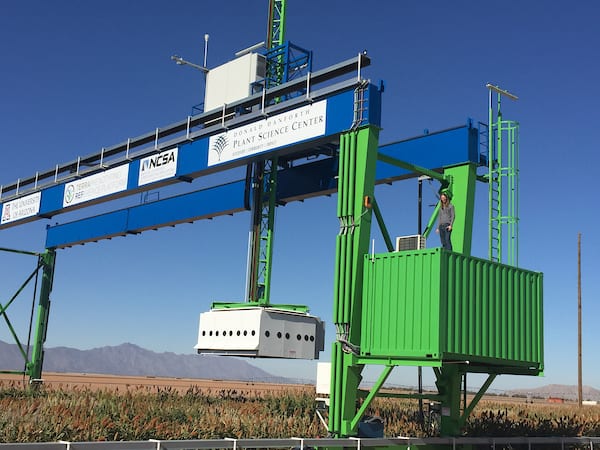The World's Largest Plant Robot
In 2015, the Danforth Center announced a multi-institutional $8M grant from the U.S. Department of Energy ARPA–E TERRA division to support a big data research program to advance the development of sorghum, a key bioenergy crop. The TERRA program led by Todd Mockler, Ph.D., member, Geraldine and Robert Virgil Distinguished Investigator, uniquely integrates agriculture, information technology and engineering communities to address major challenges in providing sustainable, affordable and abundant plant feedstocks for food and bioenergy.
As part of the project, the world’s largest agricultural robot scanner was built at the University of Arizona's Maricopa Agricultural Center (MAC). However, it’s not the structure itself that researchers are so amazed by; it’s the data that’s being collected by it. Each day, the robot scans 30,000 to 40,000 plants producing nearly five terabytes of data and high-resolution images.
“As the plant matures in the heat and drought conditions of the region, the state-of-the-art imaging sensors and cameras collect data on the physical characteristics of sorghum such as height, leaf structure and speed of growth. The facility at Maricopa provides an exceptional capability for managed stress trials in a hot and arid environment through controlled irrigation,” said Mockler.

As the TERRA project winds down, that infrastructure remains, and Mockler’s Danforth Center colleague Andrea Eveland, PhD, assistant member, among others, have new projects that will continue to use it.
Eveland’s project is leveraging the robot to deepen the understanding of sorghum, a versatile bioenergy crop, by exploring the gene regulatory networks underlying the amazing stress resilience of sorghum. Drought tolerance is a complex trait and understanding regulation in the broader context of the whole plant and its environment will require advanced approaches in genetics, genomics, phenotyping and gene editing.
“There are more than 30,000 genes in the sorghum genome and we only have knowledge of what a small fraction of them do,” said Eveland. “This is a grand challenge facing biologists now – to define the function of every gene in the genome.”
Knowledge gained from the field experiments will be used to develop technologies to increase the potential of bioenergy grasses to sustainably replace fossil fuels. That same information can also be easily translated into crop plants which will be incredibly important as we move through the 21st century.
Watch this video featured in the Wall Street Journal to learn more about the amazing technology pioneered by Danforth Center scientists and their collaborators.